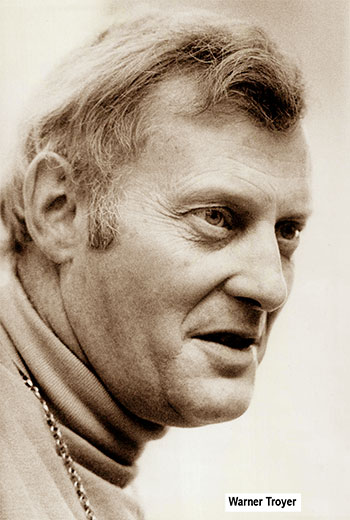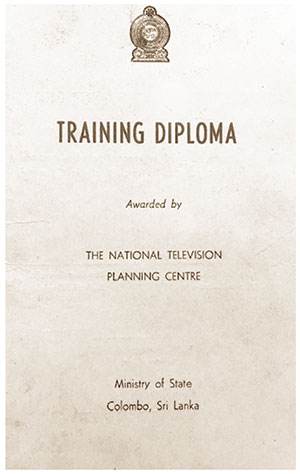Warner Troyer, Rupavahini, and me
BY GEORGE BRAINE
This was early 1981, and the government was planning to start a state-run television service. Applicants were invited for an inaugural training course for producers, directors, researchers, and writers. I had applied, and was called for an interview.
The interview was at the newly set up National Television Planning Centre, at Kirulapone. Not having any political or family “strings”, I did not expect to go beyond a cursory meeting. But, to my surprise, I was met by a ruggedly good-looking, ebullient Canadian named Warner Troyer.
I can’t recall what we discussed, but he did point to a tall stack of papers, saying he had received thousands of applications. Apparently, the glamour of television, and the opportunity to become a pioneer, were irresistible (A newspaper later reported “over 5000 applicants”). Troyer and his wife, Glenys Moss, television personalities, had been invited by the Ministry of State to train the staff needed to run the television service. They were sponsored by the Canadian International Development Agency (CIDA).
Three years earlier, a team of experts had arrived from Japan to conduct a feasibility study on a television broadcasting project. Their report, submitted in October, 1978, recommended the establishment of a studio complex in Colombo, and transmission stations at Pidurutalagala, Kandy, and Kokavil. The total cost would be Yen 3500 million (Rs. 276 million). Personnel were to be trained abroad. In the end, Japan bore the cost of construction, and the Sri Lankan government may have decided to train the personnel locally.
 The 12-week course, run by Warner and Glenys, began at the end of April, 1981. Thirty trainees, drawn from wide ranging backgrounds, were enrolled. We were university teachers, government servants, radio announcers (three from SLBC), print journalists (three from Lake House), school teachers, musicians, freelance writers, a translator, a law student, even a postmaster! Quite wisely, Warner had spread his net wide, not sticking only with journalists.
The 12-week course, run by Warner and Glenys, began at the end of April, 1981. Thirty trainees, drawn from wide ranging backgrounds, were enrolled. We were university teachers, government servants, radio announcers (three from SLBC), print journalists (three from Lake House), school teachers, musicians, freelance writers, a translator, a law student, even a postmaster! Quite wisely, Warner had spread his net wide, not sticking only with journalists.
Manique Gunasekera and I were from Kelaniya University, and Somi Sekerama, Ranjit Senaratne, Ravinatha Ariyasinha, Shiranee Dissanayake, Ramesha Balasuriya, Sunil Govinnage, Kartini Mohamed, Nalin Wijesekera, Noeline Honter, Mohamed Yahiya, and Milton Fernando are the fellow trainees I easily recall. For employees in government departments, corporations, and the university, the Ministry of State had secured duty leave.
We first met at the National Television Planning Centre, to discuss various writing assignments that Warner set for us. A skilled teacher, he was also piercingly blunt with his criticism, without naming names. (Once, I was the target.) Gradually, we were introduced to camera angles, face-to-face interviews, screenwriting, the various roles of personnel within a production team, the hands-on use of camera and recording equipment, and related matters. We also made field trips to SLBC, the Parliament, and ITN, the small television station established a few years earlier.
While the training was going on, the infrastructure for the national television service was springing up: the central transmitting station on top of Pidurutalagala, the re-transmitting stations at Kokavil and Kandy, and the studio complex in Colombo, next to the SLBC. Then, the name for the service, Rupavahini, was announced. Some trainees were giddy with excitement.
Once we had leaned the rudiments of production, six teams were formed, each tasked with the production of a short documentary. Team members, selected by Warner, consisted of a producer, director, writer, cameraman, and a researcher. As the producer of my team, I worked with Ramesha, Milton, Yahiya, and Joe Sothinathan, making decisions and coordinating the tasks.
 The Troyers were living in a sprawling two-storied house, in Borella, and the teams began meeting there. We spread out on the ground floor, in teams, brainstorming ideas for documentaries, checking out the cameras and editing equipment that had been supplied to every team. Warner and Glenys were easy-going hosts, giving us the run of their home. Warner and Glenys were always around, to answer our queries and make suggestions.
The Troyers were living in a sprawling two-storied house, in Borella, and the teams began meeting there. We spread out on the ground floor, in teams, brainstorming ideas for documentaries, checking out the cameras and editing equipment that had been supplied to every team. Warner and Glenys were easy-going hosts, giving us the run of their home. Warner and Glenys were always around, to answer our queries and make suggestions.
I lived 40km from Colombo, and took the train to Colombo. Every day, I travelled in jam-packed trains, with some passengers hanging out of the doors, a few even riding on the engine. Occasionally, this overcrowding led to brutal deaths – passengers falling off trains and getting run over, or getting their heads bashed on bridges. I also passed the vast railway yard at Maradana, where dozens of carriages sat idle, in various states of neglect, some even covered in weeds. A wasteland. The contrast was stark: overflowing trains and abandoned carriages, and I had my story.
The script got written, and we scouted locations for filming: Maradana railway station, the nearby railway yard strewn with abandoned carriages, the railway workshop at Ratmalana, and the Dematagoda crossing, among others. We got permission to film at these locations. Each team was provided with a vehicle and a driver.
When filming began, I began to take the 4.00am train from home, to be in Colombo as early as possible. I vividly recall two incidents during filming: at Dematagoda, two office trains racing each other towards Maradana, overflowing with passengers hanging out from the doors, which later became a dramatic shot in our documentary; and being hooted at by a trainload of office workers while filming crowded evening trains at Maradana station. Perhaps a group of people carrying television cameras and equipment was a never-before-seen phenomenon at that time.
In the script, I compared carriages being brought to the railway yard to “die” to the belief that elephants journey to Sinharaja for the same purpose. The lines were delivered smoothly by Milton Fernando clinging precariously to an abandoned carriage. Filming had other challenges. Another team had scheduled some shooting at the slums of Wanathamulla. A crowd of residents had surrounded the team and cast lewd remarks.
In my team, we had come up with the idea, written the script, selected the shooting locations, and imagined how the documentary would turn out. When it did, the act of creation – from idea to moving images – can only be described as seductive.
On the last day of the course, Warner and Glenys sat with all the trainees to watch the six documentaries together. The range of topics covered, the way they were handled, was fascinating, considering that, for everyone, this was the first production. Warner and Glenys must have been pleased: they had taken a group of greenhorns and brought them to the threshold of television professionalism.
A bittersweet moment, because, although the course was ending, most trainees would go on for specialized training before joining Rupavahini the following year. Not for me. For economic reasons, I had decided to take-up a foreign job.
When I met with Warner to inform him I would be leaving, he was crestfallen, saying that national television sorely needed someone with my background and skills.
I saw what he meant when my Training Diploma arrived. To quote:
“Mr. Braine brought very impressive academic, intellectual and career skills to his participation in the course.
“He is very well organized, disciplined, and highly motivated.
“Mr. Braine’s writing skills are considerable, and have shown visible improvement (in the area of television scripting) during the course.
“We believe he has a very bright potential future in the areas of educational and public affairs television, and would function very effectively as a producer”.
Somewhere deep in our hearts lurks the desire to write, to crusade, to expose corruption, to investigate criminals. I was no exception. For a news junkie, like me, to be at the creation of television in Sri Lanka, to break new ground in a medium with so much appeal, would have been a dream come true. I did regret my decision when, returning home on vacation, in 1982, I paid a visit to the gleaming, state-of-the art studio complex that the Japanese Government had gifted. My fellow trainees, assuming various roles that the Troyers had trained them for, were already producing high quality news programmes and documentaries.
I recently learned that, during a 40-year career, Warner had “conducted more than 10,000 radio and television interviews authored seven bestselling books, and written/directed/produced more than 600 documentary films”.
His best-known work, Preserving our World (1990) – described as a blueprint to save our planet – carries a posthumous dedication to Warner as someone who committed “his life to making the world a better place’.
Warner died in 1991, of throat cancer. He was only 59.
Wikipedia says that the Troyers “established a journalism school in Sri Lanka” in the early 1980s. As this narrative has shown, they did much more than that. Warner and Glenys firmly left their imprint on those early, glorious years of Rupavahini.



